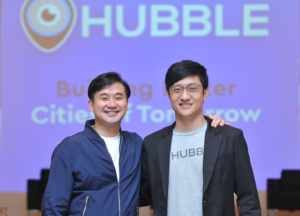There are those that always take a little longer. The construction sector is often regarded as conservative, holding on to a traditional way of doing things. Lin Shijing, a tech entrepreneur and former CEO of Singapore-based Swat Mobility, is on a mission to change that. On Friday, he presented the Hubble platform, his latest venture, in front of business leaders and government representatives.
The software intends to “unify all key stakeholders and digitalize operations” in the construction process. This includes architects, construction firms, contractors, and suppliers who are still sending each other countless paper documents back and forth. Hubble was awarded a grant from Singapore’s Building and Construction Authority (BCA) and Infocomm Media Development Authority (IMDA), aiming to prepare the industry for an “integrated digital delivery” future.
Companies signing up to the platform can benefit from a new “growth and transformation scheme” for the sector that the government announced with its 2021 budget. Further details will be released later in the year. Developers, builders, and consultants need to show that they gained productivity savings through the use of digital means.
Singapore’s government has a vested interest in having a more efficient building sector. More than half of construction tenders this year will be public works, according to the BCA. “There are sometimes bottlenecks that lead to delays,” said Lin. And hiccups can be costly.
Hubble integrates the different phases of the building life cycle, he explains, from design to fabrication, and construction, allowing “seamless collaboration and real-time command.” It includes identity management with biometric facial recognition and fleet management to make sure that drivers are on track.
Although fully autonomous construction is still some time away, the platform incorporates several high-tech elements that represent a real innovation. It allows automatic reading of floorplans, Lin illustrates. The system will then alert workers on-site when high-risk activities are developing in close proximity. Another feature detects sentiment when the parties negotiate on what to do next. “There’s a lot of shouting going on in this industry,” he quips, adding that a commanding management style is very widespread and the tool can reflect that.

Contractors can use the platform to coordinate and track their PPVC (prefabricated prefinished volumetric construction) deliveries. With the technology, standardized modules of the building are being assembled in factories, transported to the construction site where they are installed, speeding up the process.
This still won’t completely eliminate humans on construction sites yet. Lin recounts that a Japanese firm tested a robot for the inspection of walls. Knocking on them, the machine couldn’t detect many issues that an experienced worker would spot using his senses.
Hubble, which works closely with industry giant Woh Hup, says it already signed up more than 1,000 companies. Last year, it won a bid to design a COVID-19 safety platform for the country’s construction sites, which it managed to deliver within just 3 months. “This helped us onboard many users, it established confidence,” Lin said. Hubble now employs 51 people, mostly software engineers. The company just raised USD 4 million in its Series A round, led by Tin Men Capital.
Large infrastructure projects such as the Tuas Water Reclamation Plant and the Kim Chuan Depot are already using the software. Having government support certainly helps. But there is still a lot of convincing to be done within the sector, Lin explains. He trusts that the arrival of the millennials will improve the situation. They will ask for more technology and new tools, he is certain.

